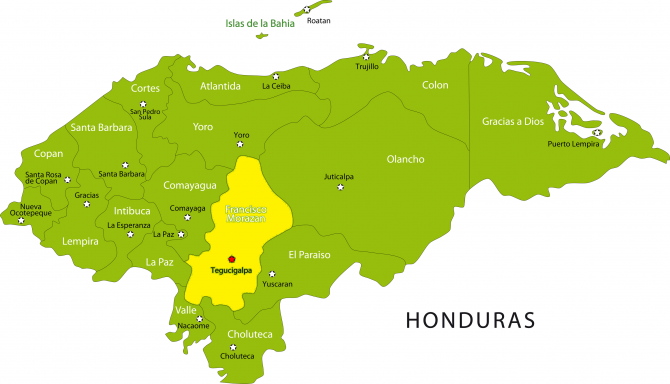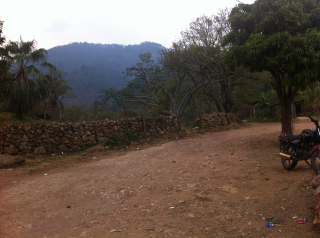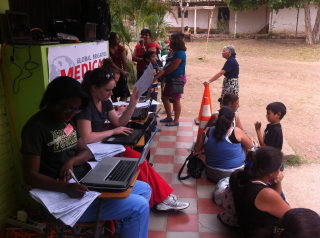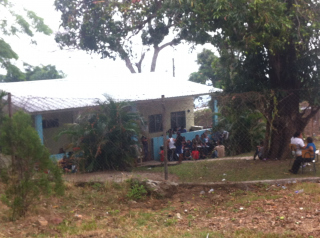Cuesta Grande, Honduras
![]()
![]()
![]()
![]()
![]()
![]()
![]() Click on Programs to learn more about their work in this community
Click on Programs to learn more about their work in this community
General Information

| Population* | 447 |
| Number of homes | 130 |
| Avg # of people per home | 3.4 |
| Number and % of children |
(0-5yrs): 67/15.0% (0-9yrs): 122/27.3% |
| Electricity | Yes |
| GPS |
N 13° 59.472’ W 087° 47.436’ |
| Altitude | N/A |
| Municipality | Tatumbla |
| Department | El Paraiso |
| Corresponding Health Center | CESAR - Cuesta Grande |
| Distance from compounds | 1 hour |
| Road conditions | Normal |
* Population does not reflect how many patients will be seen on medical
brigades as many people from surrounding communities come seeking
Medical Brigades medical attention.
Top Three Needs Expressed
The top three needs expressed by the key community members are a renovated water system, new latrines since they are now old, and more efficient stoves since they are running out of sources of wood.

Cuesta Grande is located in the Tatumbla municipality of the Fransisco Morazan department.
Cuesta Grande’s educational system includes Kinder and Primary (until 6th grade) and there are approximately 54 students. It is estimated that about 98% of the community knows how to read and write. The school director is Norma Robelo.
Cuesta Grande has a water system built by the government in 1984. The main problem with Cuesta Grande’s water system is that there is not enough water for the community. It arrives every 4 days and is chlorinated regularly by means of a pill that lasts in the tank for 1 full year. During the summertime, there is very little water available and they often have to buy water. They estimate about 96% of the community is connected to the water system. There is a Water Council that has 6 active members and Geovani Ramos is the president.
Cuesta Grande has a water system built by the government in 1984. The main problem with Cuesta Grande’s water system is that there is not enough water for the community. It arrives every 4 days and is chlorinated regularly by means of a pill that lasts in the tank for 1 full year. During the summertime, there is very little water available and they often have to buy water. They estimate about 96% of the community is connected to the water system. There is a Water Council that has 6 active members and Geovani Ramos is the president.
Cuesta Grande does have a Health Center in the community with a local nurse. There is not a community health committee nor is there access to dental care.
The most common illnesses seen by community members are respiratory infections, hypertension, and acid peptic disorders. Approximately 70% of the community has latrines that currently function. Almost 1% has eco-stoves (estufas justas). About 90% is estimated to have cement floors.
Below are some available health center statistics from CESAR-Cuesta Grande2 :
I. Annual Morbitities, 2009: CESAR-Cuesta Grande
|
Rank |
Morbidity |
Number of Cases (2009) |
|
1 |
Pharyngotonsilitis |
237 |
|
2 |
Common Cold |
87 |
|
3 |
Hypertension |
43 |
|
4 |
Intestinal Parasites |
40 |
|
5 |
Skin Allergies |
34 |
|
6 |
Acid Reflux |
27 |
|
7 |
Urinary Infection |
21 |
|
8 |
Pneumonia |
21 |
|
9 |
Diarrhea |
18 |
|
10 |
Bronchitis |
17 |
II. Caserios (small villages) served by CESAR-Cuesta Grande, 2009
|
Caserios |
Population |
Number of Homes |
Potable Water (%) |
Latrines (%) |
Malnourished Children |
Births/ % Coverage of Pregnancies |
Order of Priority (based on HC standards) |
|
CUESTA GRANDE* |
447 |
130 |
74 |
98 |
0 |
9 / 100% |
4 |
|
Maculero |
494 |
112 |
98 |
74 |
0 |
7 / 78% |
3 |
|
Santa Catana |
234 |
28 |
0 |
100 |
5 |
3 / 100% |
1 |
|
Suyatillo |
282 |
41 |
4 |
90 |
0 |
5 / 83% |
2 |
Centro de Salud Statistics, Centro de Salud Regional-Danlí, 14 Marzo 2010
The average family income per month is estimated to be 3500 Lempiras, which is approximately L700 (US $37.06) per person3. The majority of homes are made of adobe. The main form of employment in Cuesta Grande is agriculture and the main products that are cultivated are corn, beans, and a few small horticultures. Several members of the community work at the Agricultural School as well. Members of Cuesta Grande do not have a community bank, though agriculture workers and land owners have access to credit through Cooperativa Sagrada Familia.
Cuesta Grande has previously received medical brigades from the municipality, most recently in 2009. Cuesta Grande and its health center serve 3 other small surrounding villages called Suyatillo, Santa Catacina, and Maquelizo.
 |
|||||
 |
Source of information: Key informant interview
Date of interview: 14 April 2010
1The accepted regulation frequency for chlorinating water is every 4 days.
2CESAMO and CESAR are terms used for types of health centers. CESAMOs are larger, more comprehensive facilities that usually have a physician on staff at all times and occasionally a dentist. CESARs are more remote, less equipped facilities, usually with
1-2 nurses on staff.
3According to Red Solidaria and World Food Programme in Honduras, the average family is approximated at 5 people per household, the poverty line is L930 (US$49.23) per person per month, and the extreme poverty line is L617 (US$32.66) per person per month.

